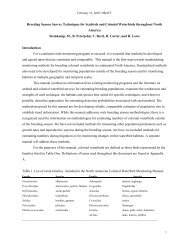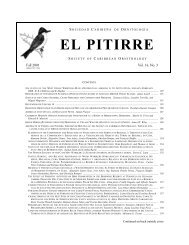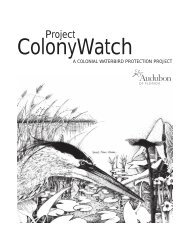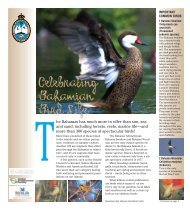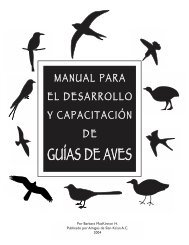body draft - Society for the Conservation and Study of Caribbean Birds
body draft - Society for the Conservation and Study of Caribbean Birds
body draft - Society for the Conservation and Study of Caribbean Birds
- No tags were found...
Create successful ePaper yourself
Turn your PDF publications into a flip-book with our unique Google optimized e-Paper software.
BIRDING IN THE DOMINICAN REPUBLIC AND PUERTO RICO — LITHNERFrom <strong>the</strong> viaduct at <strong>the</strong> main road, we ascendedtoward <strong>the</strong> Sierra de Baruco to search <strong>for</strong> GoldenSwallows near some old Bauxite mines about 1200m above sea level, but no swallows were found. SeveralWhite-winged Crossbills were encountered atvarious places at this altitude.24 September. – Additional searches <strong>for</strong> Ridgway’sHawk along <strong>the</strong> coast south <strong>of</strong> Barahona were unsuccessful,despite several hours <strong>of</strong> intensive observation.At Laguna del Rincón, we found a Forster´s Tern(Sterna <strong>for</strong>steri), two Gull-billed Terns (Sternanilotica), <strong>and</strong> eight Caspian Terns (Sterna caspia).At Lago Enriquillo, 1.3 km (0.8 mi) north <strong>of</strong> Baitoa,we saw Greater Flamingos (Phoenicopterus ruber)<strong>and</strong> a flock <strong>of</strong> 111 Snowy Egrets (Egretta thula). Asingle adult American Golden-Plover (Pluvialis dominica),molting into winter plumage, was observedon a s<strong>and</strong>-bed about 100 m inl<strong>and</strong> from <strong>the</strong> waterfront,<strong>and</strong> about 10 Black Terns (Chlidonias niger)were hunting over <strong>the</strong> water. Here we found our onlyAntillean Nighthawk (Chordeiles gundlachii). Justafter 17:00 hr, we heard about 10 White-neckedCrows going to roost at La Zorza.25 September. – In <strong>the</strong> morning only three BurrowingOwls were flushed as we drove toward PuertoEscondido. About 3.7 km (2 mi) beyond <strong>the</strong> threewaycrossing at Puerto Escondido, we heard HispaniolanNightjars <strong>and</strong> Helmeted Guineafowl(Numida meleagris) calling.After four days <strong>of</strong> unfulfilled ef<strong>for</strong>t searching <strong>for</strong><strong>the</strong> Flat-billed Vireo in suitable habitat, we redoubledour ef<strong>for</strong>ts by using playbacks <strong>of</strong> its vocalizationsat stops every 0.8 km (0.5 mi) from <strong>the</strong> NationalPark sign, <strong>the</strong> highest site <strong>for</strong> this species accordingto o<strong>the</strong>r reports, down toward Puerto Escondido.On our second stop a bird flew up to <strong>the</strong> MDplayer,fluttered <strong>for</strong> about a second <strong>and</strong> disappearedagain, without being identified. At our fifth stop, 4.2km (2.6 mi) downhill from <strong>the</strong> National Park sign, aFlat-billed Vireo silently hopped <strong>and</strong> flew short distancesto within about 1 m <strong>of</strong> <strong>the</strong> MD-player.Thereafter, we turned uphill again, playing <strong>the</strong> vocalrecordings <strong>for</strong> o<strong>the</strong>r species <strong>and</strong> hearing RuddyQuail-Doves (Geotrygon montana) <strong>and</strong> HispaniolanLizard-Cuckoos. A Key West Quail-Dove (Geotrygonchrysia) called at 22.7 km (14.1 mi) from <strong>the</strong>three-way-cross <strong>and</strong> 9.5 km (5.9 mi) be<strong>for</strong>e <strong>the</strong> militarycheckpoint. Again searching <strong>for</strong> Golden Swallowsaround “The Bulldozer,” we only found TreeSwallows <strong>for</strong>aging around <strong>the</strong> military checkpoint.26 September. – We found six White-cheeked Pintails(Anas bahamensis) at Los Cocos en route toPedernales. We searched <strong>for</strong> rails in <strong>the</strong> wetl<strong>and</strong>salong <strong>the</strong> side <strong>of</strong> <strong>the</strong> road to Cabo Rojo, but foundnone. Felíz noted that <strong>the</strong>re was more water thanusual, which limited <strong>the</strong> possibility <strong>of</strong> locating rails.Never<strong>the</strong>less, we did encounter White-rumped S<strong>and</strong>piper(Calidris fuscicollis), Black-billed Cuckoo(Coccyzus erythropthalmus), <strong>and</strong> Yellow Warbler(Denroica petechia).From <strong>the</strong> viaduct at <strong>the</strong> main road we drove uphill14.5 km (9 mi) to Acetillar, where we heard an EasternChat-Tanager just be<strong>for</strong>e entering <strong>the</strong> pine <strong>for</strong>est.Here we also saw our first Antillean Euphonia(Euphonia musica), as well as two Antillean Piculets.Although Felíz in<strong>for</strong>med us that TawnyshoulderedBlackbirds (Agelaius humeralis) can befound along <strong>the</strong> pine <strong>for</strong>est edge during <strong>the</strong> breedingseason, when <strong>the</strong>y are quite vocal <strong>and</strong>, <strong>the</strong>re<strong>for</strong>e,easy to locate, we failed to find <strong>the</strong>m. The onlyWhite-crowned Pigeons (Columba leucocephala)during our trip were seen here.On our way back to <strong>the</strong> main road, while still in<strong>the</strong> pine frorest, Mr Felíz heard a Gray-crownedPalm-Tanager (Phaenicophilus poliocephalus) at33.0 km (20.5 mi) from <strong>the</strong> viaduct (about 2.4 km[1.5 mi] above Acetillar). The bird was observed,<strong>and</strong> <strong>the</strong> Black-crowned Palm-Tanager was also seenhere. The White-winged Crossbill was quite commonat <strong>the</strong>se elevations in <strong>the</strong> <strong>Caribbean</strong> pine (Pinuscaribaea) <strong>for</strong>est.Still seeking <strong>the</strong> Golden Swallow, we crossed <strong>the</strong>Sierra de Baoruco, but had to settle <strong>for</strong> Cave Swallows(Hirundo fulva) which were more common thanexpected at <strong>the</strong>se elevations. Be<strong>for</strong>e leaving <strong>the</strong> rain<strong>for</strong>est on our descent <strong>of</strong> <strong>the</strong> eastern slope, we stoppedto study some parakeets, <strong>and</strong> found <strong>the</strong>m to be OlivethroatedParakeets (Aratinga nana), a species onlyrecently discovered in this area (Raffaele et al.: 309).We tried again <strong>for</strong> Ridgway’s Hawk after leaving <strong>the</strong>rain <strong>for</strong>est, but again were unsuccessful. Felíz told us<strong>the</strong> hawk is seen most <strong>of</strong>ten over <strong>the</strong> dry, semi-opencountry between <strong>the</strong> foothills <strong>and</strong> Puerto Escondido.At 19:00 we were back in Barahona. Mr Feliz <strong>of</strong>feredto help us in our search <strong>for</strong> <strong>and</strong> MangroveCuckoo (Coccyzus minor) <strong>the</strong> next day.27 September. – At Buelta de Cariño about 1.6 km(10 mi) south <strong>of</strong> Barahona, we searched <strong>for</strong> GrayheadedQuail-Dove (Geothrygon caniceps) <strong>and</strong>Black-whiskered Vireo (Vireo altiloquus). Althoughquail-doves were flushed five times while we werewalking a path, we were not able to identify <strong>the</strong>m tospecies. We did, however, manage to identify threeRuddy Quail-Doves. After a long search we man-El Pitirre 14(1) Page 13




